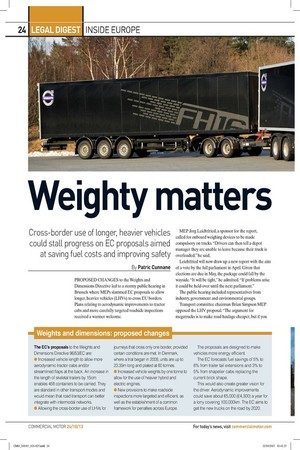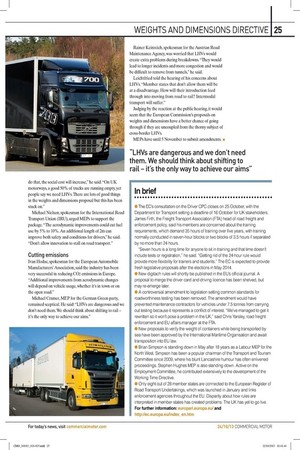Weighty matters
Page 18

Page 19

If you've noticed an error in this article please click here to report it so we can fix it.
Cross-border use of longer, heavier vehicles could stall progress on EC proposals aimed at saving fuel costs and improving safety By Patric Cunnane
PROPOSED CHANGES to the Weights and Dimensions Directive led to a stormy public hearing in Brussels where MEPs slammed EC proposals to allow longer, heavier vehicles (LHVs) to cross EU borders. Plans relating to aerodynamic improvements to tractor cabs and more carefully targeted roadside inspections received a warmer welcome.
MEP Jorg L,eichtfried, a sponsor for the report, called for onboard weighing devices to be made compulsory on trucks. "Drivers can then tell a depot manager they are unable to leave because their truck is overloaded," he said.
Leichtfried will now draw up a new report with the aim of a vote by the full parliament in April. Given that elections are due in May, the package could fall by the wayside. "It will be tight," he admitted. "If problems arise it could be held over until the next parliament."
The public hearing included representatives from industry, government and environmental groups. Transport committee chairman Brian Simpson MEP opposed the LHV proposal. "The argument for megatrucks is to make road haulage cheaper, but if you
do that, the social cost will increase," he said. "On UK motorways, a good 50% of trucks are running empty, yet people say we need LHVs. There are lots of good things in the weights and dimensions proposal but this has been stuck on."
Michael Nielsen, spokesman for the International Road Transport Union (IRU), urged MEPs to support the package. "The aerodynamic improvements could cut fuel use by 5% to 10%. An additional length of 2m can improve both safety and conditions for drivers," he said. "Don't allow innovation to stall on road transport." Cutting emissions
Ivan Hodac, spokesman for the European Automobile Manufacturers' Association, said the industry has been very successful in reducing CO2 emissions in Europe. "Additional improvements from aerodynamic changes will depend on vehicle usage, whether it's in town or on the open road."
Michael Cramer, MEP for the German Green party, remained sceptical. He said: "LHVs are dangerous and we don't need them. We should think about shifting to rail — it's the only way to achieve our aims."
Rainer Keinreich, spokesman for the Austrian Road Maintenance Agency, was worried that LHVs would create extra problems during breakdowns. "They would lead to longer incidents and more congestion and would be difficult to remove from tunnels," he said.
Leichtfried told the hearing of his concerns about LHVs. "Member states that don't allow them will be at a disadvantage. How will their introduction feed through into moving from road to rail? Intermodal transport will suffer."
Judging by the reaction at the public hearing, it would seem that the European Commission's proposals on weights and dimensions have a better chance of going through if they are uncoupled from the thorny subject of cross-border LHVs. MEPs have until 5 November to submit amendments. • "LHVs are dangerous and we don't need them. We should think about shifting to rail it's the only way to achieve our aims" Weights and dimensions: proposed changes The EC's proposals to the Weights and Dimensions Directive 96/53/EC are:
• Increased vehicle length to allow more aerodynamic tractor cabs and/or streamlined flaps at the back. An increase in the length of skeletal trailers by 15cm enables 45ft containers to be carried. They are standard in other transport modes and would mean that road transport can better integrate with intermodal networks. • Allowing the cross-border use of LHVs for
journeys that cross only one border, provided certain conditions are met. In Denmark, where a trial began in 2008, units are up to 23.35m long and plated at 60 tonnes.
• Increased vehicle weights by one tonne to allow for the use of heavier hybrid and electric engines.
• New provisions to make roadside inspections more targeted and efficient, as well as the establishment of a common framework for penalties across Europe.
The proposals are designed to make vehicles more energy efficient.
The EC forecasts fuel savings of 5% to 8% from trailer tail extensions and 3% to 5% from shapelier cabs replacing the current brick shape.
This would also create greater vision for the driver. Aerodynamic improvements could save about €5,000 (£4,300) a year for a lorry covering 100,000km. The EC aims to get the new trucks on the road by 2020. In brief
• The EC's consultation on the Driver CPC closes on 25 October, with the Department for Transport setting a deadline of 16 October for UK stakeholders. James Firth, the Freight Transport Association (FTA) head of road freight and enforcement policy, said his members are concerned about the training requirements, which demand 35 hours of training over five years, with training normally conducted in seven-hour blocks or two blocks of 3.5 hours if separated by no more than 24 hours.
"Seven hours is a long time for anyone to sit in training and that time doesn't include tests or registration," he said. "Getting rid of the 24-hour rule would provide more flexibility for trainers and students." The EC is expected to provide fresh legislative proposals after the elections in May 2014.
• New digitach rules will shortly be published in the EU's official journal. A proposal to merge the driver card and driving licence has been shelved, but may re-emerge later.
• A controversial amendment to legislation setting common standards for roadworthiness testing has been removed. The amendment would have prevented maintenance contractors for vehicles under 7.5 tonnes from carrying out testing because it represents a conflict of interest. "We've managed to get it rewritten so it won't pose a problem in the UK," said Chris Yarsley, road freight enforcement and EU affairs manager at the FTA.
• New proposals to verify the weight of containers while being transported by sea have been approved by the International Maritime Organisation and await transposition into EU law.
• Brian Simpson is standing down in May after 18 years as a Labour MEP for the North West. Simpson has been a popular chairman of the Transport and Tourism Committee since 2009, where his blunt Lancashire humour has often enlivened proceedings. Stephen Hughes MEP is also standing down. Active on the Employment Committee, he contributed extensively to the development of the Working Time Directive. • Only eight out of 28 member states are connected to the European Register of Road Transport Undertakings, which was launched in January and links enforcement agencies throughout the EU. Disparity about how rules are interpreted in member states has created problems. The UK has yet to go live. For further information: europarl.europa.eu/ and http://ec.europa.eu/index en.htm








































